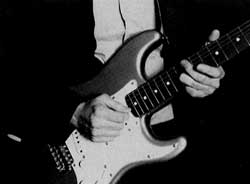

![]() Guitars:
Guitars:
Robert Quine's first electric guitar was a double-cutaway Danelectro with two pickups and a gold finish, which he got with a case and amplifier for $130. These days, though, "I pretty much stick to Fenders," Quine says of his impressive guitar collection.
In 1961 he got his first Fender Stratocaster the guitar he has been identified with for most of his career. His infatuation with the Strat was directly inspired by his idol, Ritchie Valens: "I saw the picture on the cover of his first album, and he had a Stratocaster. I didn't know what it was, but I knew I had to have one."
In 1996 Quine switched to the Fender Telecaster. "In the late '90s, Chris Cush of [New York City's] Mojo Guitars rewired a lot of Telecasters for me," Quine notes. My favorite right now is a Fender '52 reissue, with Seymour Duncan Antiquities pickups and a four-way switch. Rick Kelly of Carmine Street Guitars has been building some amazing Telecasters lately, and that's probably what I'll get next."
Quine prefers to string his guitars with Fender Silver Bullets - the standard .010 to .038 set.
Amps:
Along with his first Strat, Quine got a Tremolux amp - one of Fender's first piggy-back models. He owns several vintage Fender tube amps, including: "The greatest amp I've ever owned - a little Fender Super Champ with the stock Fender speaker, not the Electro-Voice." Quine has used - on tours and in the studio - a Peavey Special 130, a Peavey Deuce Tube, a Fender Reverb II, and dozens of other Fender vintage and reissue amplifiers over the years. "The Fender Reissue amps are great; also the Pro Junior and the Custom Vibrolux," he points out.
Effects:
"I've been using an Electro-Harmonix Deluxe Memory Man for about 21 years now, and nothing will ever replace it. I discovered [the] Memory Man when I played briefly with Robert Gordon, and now I'm totally addicted to it. I'm never without it. I practice with it and I've learned to use it as a real musical instrument," Quine says. "That particular box will get sounds that you can't get out of anything else. You could put another analog delay and a chorus together, and you would not get the sounds that this thing gets, because the chorus effect operates not on the direct signal but on the echo signal."

Ever in search of new and strange guitar sounds, Quine owns dozens of fuzz boxes - an original Fender Blender, a Dallas/Arbiter Fuzz Face, and the MXR Distortion+ among them - true classics, each with its own distinct sound. "Prescription Electronics has done a lot of amazing things in the last six years. Their Yardbox is my all-time favorite fuzz, a sound I'd been searching for for about 30 years. I'm a big fan of the Beck/Page Yardbirds sound, and this does it exactly!"
Expounding on his utilization of effects, Quine notes: "Onstage, I don't have a lot of effects boxes, because too many things can go wrong. My rule is to keep things as simple as possible! If I can just get a basic sustain and a gutsy kind of tone where I can scream in a blues fashion, then I'm happy."
"Recording is different - I'll often have five or six boxes lined up," he adds. "The Experience [also by Prescription Electronics] is a unique invention; I always bring it with me when I record. It does too many things to mention here but some examples are a massive '60s fuzz, fuzz with an endless sustain and beautiful octave effect, backwards-sounding solos, and broken speaker and amp sounds for the more demented."
"In the last six years, stomp boxes are better than ever. I'm guessing this won't last forever," Quine warns. "A lot of great stuff will probably disappear in the next few years, so ... a word to the wise."